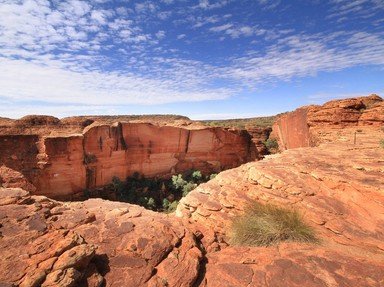Quiz Answer Key and Fun Facts
1. In Darwin, the capital city of the Northern Territory, we notice that all the buildings seem very new and modern-looking. A local tells us that this is because on Christmas Eve, 1974, the city of Darwin was all but flattened by a tropical cyclone. What was the cyclone's name?
2. Hitting the road in our 4-wheel drive (a must for travelling on outback roads!), we head due east out of Darwin en route to one of the many national parks in the Northern Territory. This one has been accorded double World Heritage status by the United Nations because of both its cultural and natural significance. Where are we going?
3. We join the Stuart Highway and travel south on the way to a magnificent gorge with a very feminine name.
4. Travelling south along the Stuart Highway, we enter outback Australia. Our next destination became one of the stations on the Overland Telegraph Line in 1872 and was at the centre of Australia's last great goldrush in the 1930s. What is the name of our next stop?
5. We take a slight detour off the Stuart Highway to take in another of nature's wonders. We pull up to an area that has large boulders scattered all over it, like a giant has been playing a game. What are we looking at?
6. Travelling south on the extensive Stuart Highway, we're not far from our next destination, but before we get there, we cross an imaginary line circling the Earth that officially separates tropical regions from the temperate zone. What is this imaginary line called?
7. We're about to enter the next town on our itinerary. This place is an important cog in the wheel of Australia's Royal Flying Doctor Service (RFDS) and was named after the wife of Charles Todd (the instigator of the Overland Telegraph Line). We're driving into _________.
8. Waving goodbye to the locals (while wondering why they're running along what seems to be a dry riverbed in some kind of strange land-bound boat race ... oh well!), we head slightly southwest this time on the way to our next destination. On the way, we see a beautiful mountain range off in the distance. What is its name?
9. Our next destination is one of Australia's best-known landmarks and one of the largest monoliths in the world.
10. As we approach this destination, we can see a series of rounded dome-shaped rocks rising from the ground. What is their name?
Source: Author
NatalieW
This quiz was reviewed by FunTrivia editor
minch before going online.
Any errors found in FunTrivia content are routinely corrected through our feedback system.

